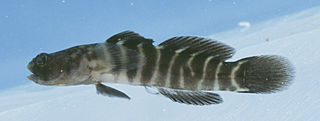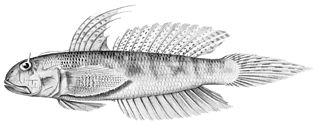
Gobiidae or gobies is a family of bony fish in the order Gobiiformes, one of the largest fish families comprising more than 2,000 species in more than 200 genera. Most of gobiid fish are relatively small, typically less than 10 cm (3.9 in) in length, and the family includes some of the smallest vertebrates in the world, such as Trimmatom nanus and Pandaka pygmaea, Trimmatom nanus are under 1 cm long when fully grown, then Pandaka pygmaea standard length are 9 mm (0.35 in), maximum known standard length are 11 mm (0.43 in). Some large gobies can reach over 30 cm (0.98 ft) in length, but that is exceptional. Generally, they are benthic or bottom-dwellers. Although few are important as food fish for humans, they are of great significance as prey species for other commercially important fish such as cod, haddock, sea bass and flatfish. Several gobiids are also of interest as aquarium fish, such as the dartfish of the genus Ptereleotris. Phylogenetic relationships of gobiids have been studied using molecular data.

Eleotridae is a family of fish commonly known as sleeper gobies, with about 34 genera and 180 species. Most species are found in the tropical Indo-Pacific region, but there are also species in subtropical and temperate regions, warmer parts of the Americas and near the Atlantic coast in Africa. While many eleotrids pass through a planktonic stage in the sea and some spend their entire lives in the sea; as adults, the majority live in freshwater streams and brackish water. One of its genera, Caecieleotris, is troglobitic. They are especially important as predators in the freshwater stream ecosystems on oceanic islands such as New Zealand and Hawaii that otherwise lack the predatory fish families typical of nearby continents, such as catfish. Anatomically, they are similar to the gobies (Gobiidae), though unlike the majority of gobies, they do not have a pelvic sucker.

Mudskippers are any of the 23 extant species of amphibious fish from the subfamily Oxudercinae of the goby family Oxudercidae. They are known for their unusual body shapes, preferences for semiaquatic habitats, limited terrestrial locomotion and jumping, and the ability to survive prolonged periods of time both in and out of water.

Gobiodon is a genus of gobies also known as coral gobies or "clown gobies". Generally, coral gobies, unlike the rest of the family Gobiidae, are not burrowers, but instead prefer to inhabit the branches of certain Acropora or similar hard corals.

Brachygobius is a small genus of gobies. They are popular aquarium fish where a number of species are sold as bumblebee gobies because their colours are similar to those of bumblebees.

Gobius is a genus of fish in the family Gobiidae native to fresh, brackish and marine waters of and around Europe, Africa and Asia. It contains the typical gobies, being the type genus of the formerly recognised subfamily Gobiinae and family and the namesake genus of its order Gobiiformes.

Knipowitschia is a genus of marine, fresh and brackish water gobies native to Eurasia. The genus name almost certainly honours Nikolai Mikhailovich Knipovich (1862-1938), a biologist who led a number of expeditions to the Caspian Sea.

Mugilogobius is a genus of fish in the family Gobiidae. They are found in fresh, brackish and marine water of the Indo-Pacific region. Several of the freshwater species have highly restricted distributions.

Neogobius is a genus of gobies, native to Black Sea and the Caspian Sea basins. It is part of the broader Benthophilinae subfamily which is also endemic to the same region. Nevertheless, two Neogobius species have recently turned out to be highly invasive and spread across Europe and even to the Great Lakes of North America.

Pomatoschistus is a genus of gobies native to fresh, brackish and marine waters of Europe, the eastern Atlantic Ocean and the Mediterranean Sea.

Elacatinus is a genus of small marine gobies, often known collectively as the neon gobies. Although only one species, E. oceanops, is technically the "neon goby", because of their similar appearance, other members of the genus are generally labeled neon gobies, as well. Except for a single East Pacific species, all reside in warmer parts of the West Atlantic, including the Caribbean and Gulf of Mexico. They are known for engaging in symbiosis with other marine creatures by providing them cleaning service that consists of getting rid of ectoparasites on their bodies. In return, Elacatinus species obtain their primary source of food, ectoparasites.

The Gobiiformes are an order of fish that includes the gobies and their relatives. The order, which was previously considered a suborder of Perciformes, is made up of about 2,211 species that are divided between seven families. Phylogenetic relationships of the Gobiiformes have been elucidated using molecular data. Gobiiforms are primarily small species that live in marine water, but roughly 10% of these species inhabit fresh water. This order is composed chiefly of benthic or burrowing species; like many other benthic fishes, most gobiiforms do not have a gas bladder or any other means of controlling their buoyancy in water, so they must spend most of their time on or near the bottom. Gobiiformes means "goby-like".

Ponticola is a genus of gobies native mostly to fresh waters of the Black Sea - Caspian Sea region in Eurasia. Some species occur in the brackish-water Black and Caspian seas themselves. It was considered to be part of the broader goby subfamily Benthophilinae, also endemic to the same region, although the 5th edition of Fishes of the World does not list any subfamilies in the Gobiidae. Originally, Ponticola was described as subgenus of Neogobius.

The tadpole-gobies (Benthophilus), also called pugolovkas, are a genus of Ponto-Caspian fish in the family Gobiidae.

Tridentiger is a genus of fish in the subfamily of gobies called the Gobionellinae, known commonly as the tripletooth gobies.

The Gobionellinae are a subfamily of fish which was formerly classified in the family Gobiidae, the gobies, but the 5th Edition of Fishes of the World classifies the subfamily as part of the family Oxudercidae. Members of Gobionellinae mostly inhabit estuarine and freshwater habitats; the main exception is the genus Gnatholepis, which live with corals in marine environments. The subfamily is distributed in tropical and temperate regions around the world with the exception of the northeastern Atlantic Ocean, the Mediterranean Sea, and the Ponto-Caspian region. It includes around 370 species and 55 genera: Wikipedia articles about genera list about 389 species.

Gobiosoma is a genus of gobies native to fresh, brackish and marine waters of the Americas.

Oxyurichthys is a genus of fish in the subfamily Gobionellinae, commonly known as arrowfin gobies. They are distributed in the tropical and subtropical Indian and Pacific Oceans; one species is also known from the western Atlantic Ocean. Most species live in shallow waters under 10 meters deep over fine substrates such as silt.

Chaenogobius annularis, the fork-tongued goby, is a species of goby from the subfamily Gobionellinae which is found in the brackish waters of temperate eastern Asia. It is the type species of the genus Chaenogobius.



















